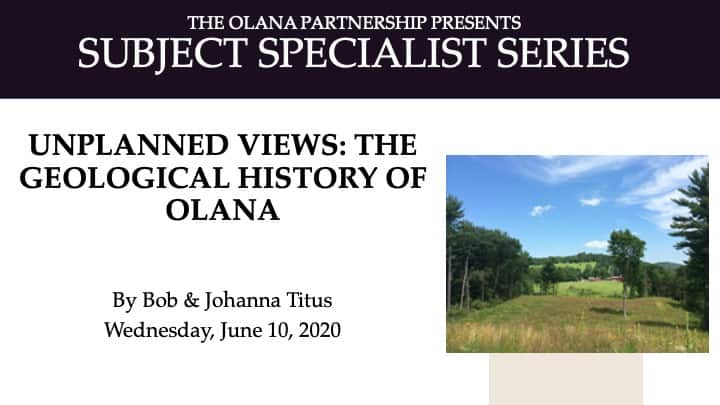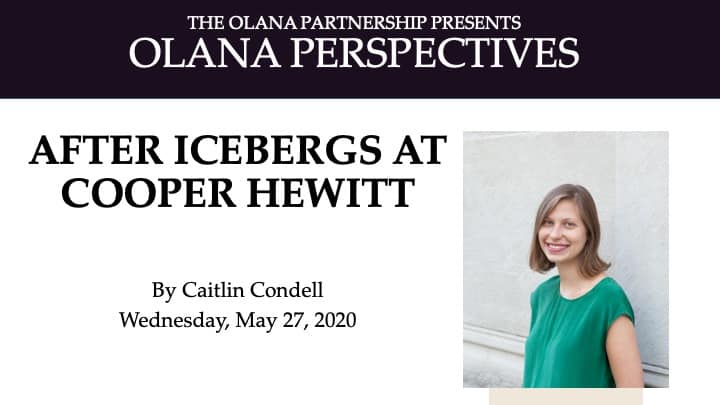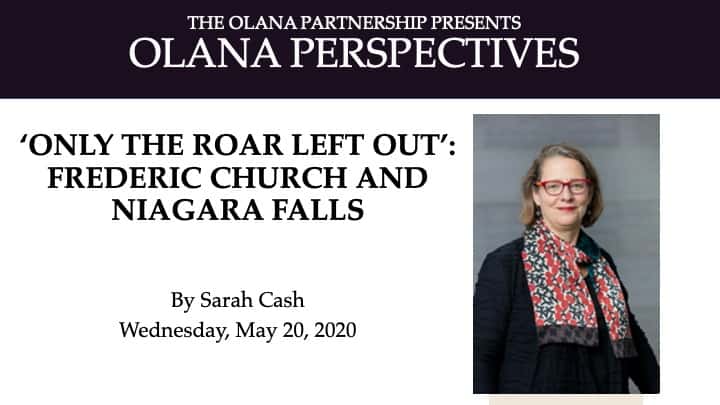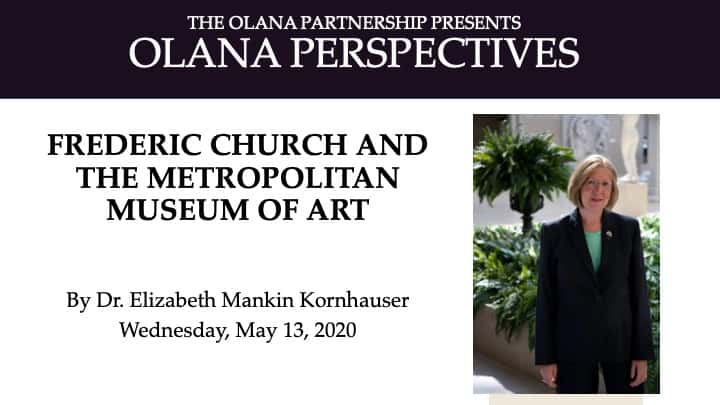Webinars
Adding India: Lockwood de Forest’s Contribution to Olana’s Interiors
July 8, 2020
Sarah Coffin is an independent decorative arts and design consultant, curator, and lecturer, who is a member of Olana’s National Advisory Committee, Most recently for over 14 years, she was Senior Curator and Head of the Product Design and Decorative Arts Department at Cooper Hewitt Smithsonian Design Museum from which she retired in 2018. While there she curated blockbuster exhibitions on the Jazz Age, Van Cleef & Arpels jewelry, Rococo design from 1730-2008 and Feeding Desire on Dining Design from 1500-2005. In addition she oversaw the creation of the Permanent Collections floor with five exhibitions opening simultaneously for the renovated museum re-opening in 2014. One of the exhibitions she co-curated then was Passion for the Exotic: Lockwood de Forest and Frederic Church, featuring the museum’s de Forest-designed Teak Room and works, primarily from the collection with loans from Olana.
Lockwood de Forest (1850-1932), a painter and interior designer started his artistic career painting with Frederic Church at Olana. Related by marriage to Church, de Forest stayed at Olana during the 1870s, where he studied books in Church’s library on middle eastern design by Pascal Coste and Jules Bourgoin. In 1869 de Forest and Church travelled, painted and shopped in Greece and the Middle East with their families. The purchases appear in both Olana and Lockwood de Forest’s first interior design commission − his parents’ New York house of 1876. De Forest’s main contribution to Olana came after he set up an studio of mastercraftmen in the Indian city of Ahmedabad, in Gujarat in 1880-81 for the production of woodwork, metalwork, and other decorative designs. This talk will go inside Olana on a virtual tour of elements and furniture provided by de Forest, mostly from his Indian studio, supplemented by images of
other work by de Forest and related Indian sources, with special reference to how he and Church collaborated at Olana.
Frederic Church’s Middle Eastern Costume Collection: Its Inspiration and Impact
June 24, 2020
Hanan Munayyer is President of the Palestinian Heritage Foundation and a scholar and curator specializing in Palestinian and other Arab traditional dress. Her many exhibition credits include an important contribution as an advisor and essayist for Olana’s 2018 exhibition Costume and Custom: Middle Eastern Threads at Olana, which was guest curated by textile historian Lynne Z. Bassett. She has lectured widely for universities and museums and she co-produced and wrote the script of the 1990 documentary Palestinian Costumes and Embroidery: A Precious Legacy. Since 2009, Ms. Munayyer has been a member of the New Jersey Arab-American Heritage Commission, a state entity to which she was appointed by the governor. In 2011, she published the award-winning book Traditional Palestinian Costume: Origins and Evolution with Interlink Books, the result of 24 years of research about the origins of Middle Eastern textile arts and the evolution of Palestinian costumes and crafts.
As Frederic and Isabel Church travelled in Syria, Lebanon and Palestine in 1868, they commented on the “picturesque costumed individuals” (Isabel’s diary, 1868) they saw, inspiring them to bring back to Olana some costumes that are now some of the oldest extant Palestinian and Syrian costume items in any collection. They were featured in Church’s paintings of the Middle East, and were used in “a la Turque” parties at Olana. This collection will be reviewed in this presentation.
Frederic Church’s fascination with architectural decorations of the mansions in Damascus and Jerusalem that inspired the design of Olana also resulted in the acquisition of some “stones from a house in Damascus” (Church letter to W. Osborn, 1868) ) and numerous wall and door designs from Jerusalem that are on display at numerous locations at Olana. These will be highlighted.
Unplanned Views: The Geological History of Olana
June 10, 2020
Robert and Johanna Titus are retired professors of geology and biology. As popular science writers, they have authored four books and a thousand articles about the geology of the Hudson Valley. For years they have been studying how Ice Age glaciers sculpted the landscapes painted by members of the Hudson River School of Art. They have developed a theory that ice age activities had a lot to do with the development of what has been called the “sublime” by art historians and believe that an understanding of ice age history is necessary to fully appreciate our regions’ landscape art.
The 250 acres of land that comprise Frederic Church’s OLANA became the canvas for his pioneering endeavors in landscape architecture. Participants will learn about the geological history of Olana and the forces that shaped the 19th-century Hudson River School artist’s designed landscape. Specifically, Church contoured the grounds in order to create what are called “planned views.” Bob and Johanna Titus will visit three of Frederic Church’s best views and take us back in time to describe how the ice age glaciers sculpted them into the scenic sites that Church could tease from obscurity into landscape beauty. See the Hudson Valley and Olana’s landscape with new eyes—the eyes of scientists who see where science meets storytelling and time travel is possible.
Olana Perspectives: After Icebergs at Cooper Hewitt
May 27, 2020
Caitlin Condell is the associate curator and head of the Department of Drawings, Prints, and Graphic Design at Cooper Hewitt, Smithsonian Design Museum where she oversees a collection of nearly 147,000 works on paper dating from the fourteenth century to the present. She has organized and contributed to numerous exhibitions and publications, including After Icebergs (2019–20), Nature—Cooper Hewitt Design Triennial(2019–20), Fragile Beasts (2016–17), Making Design (2014–15), and How Posters Work (2015), at Cooper Hewitt, and Making Room: The Space between Two and Three Dimensions (2012–13), at the Massachusetts Museum of Contemporary Art (MASS MoCA). Her publication E. McKnight Kauffer: The Artist in Advertising will be published by Rizzoli Electa in October, and the related exhibition Underground Modernist: E. McKnight Kauffer will open at Cooper Hewitt in December 2020.
In the summer of 1859, Frederic Edwin Church (1826-1900)—the most celebrated American landscape painter of his time—journeyed to Newfoundland and Labrador to study and sketch icebergs. Arctic exploration had captured the imagination of the public in the preceding decades, and Church was lured to the North Atlantic by accounts of a surreal polar landscape. These studies, drawn from Cooper Hewitt’s collection of over 2,000 drawings by Church, offer us a moment to reflect with reverence on the fragility of our natural world. One hundred and sixty years later, Church’s studies are at once seductive and frighteningly poignant. Join curator Caitlin Condell as she gives a virtual tour of the exhibition After Icebergs at Cooper Hewitt, Smithsonian Design Museum and tells the story of how Church’s sketches came to Cooper Hewitt.
Olana Perspectives:”Only the Roar Left Out”: Frederic Church and Niagara Falls
May 20, 2020
Sarah Cash is Associate Curator of American and British Paintings at the National Gallery of Art, Washington. Previously she served as curator of American art at the Corcoran Gallery of Art, director of the Maier Museum of Art at Randolph-Macon Woman’s College, and Assistant Curator at the Amon Carter Museum. She has also held positions at Yale University Art Gallery and the National Portrait Gallery, in addition to previous positions at the National Gallery of Art.
This lecture presents aspects of Cash’s ongoing research into Frederic Church’s paintings and drawings of Niagara Falls, focusing on one of the most important landscape paintings in the history of American art—and an emblem of the Corcoran Gallery of Art’s historic legacy at the National Gallery of Art—Niagara (1857). Featuring the rich holdings of art and archival materials held by Olana, the lecture will reveal the artist’s working methods in creating Niagara and his two other large-scale exhibition paintings of the falls; these date to 1862 (unlocated) and 1867 (National Galleries of Scotland). Prints reproducing Niagara, as well as the promotional pamphlet accompanying the work on its extensive international tour, demonstrate how the painting established the artist’s reputation as the greatest landscape painter in North America.
Olana Perspectives: Frederic Church and the Metropolitan Museum of Art
May 13, 2020
Dr. Elizabeth Mankin Kornhauser is the Alice Pratt Brown Curator of American Paintings and Sculpture at The Metropolitan Museum of Art (appointed in 2010) where she served as co-curator for the Met’s major exhibition: Thomas Cole’s Journey: Atlantic Crossings, in 2018, and which traveled to the National Gallery, London.
This talk focuses on the extraordinary role played by Frederic Church (1826-1900) as a founding trustee of The Metropolitan Museum of Art. The Museum is celebrating the artist’s legacy this year as part of the larger program for its 150th anniversary, both in the American Wing galleries as well as in the museum’s special exhibition, “Making the Met,” which you will be able to see when they re-open. Church helped to establish the broad vision and ambition for the museum during his thirty-year tenure as a Met trustee by adding works of art to the fledgling collections, and inspiring a legacy for American art that led to a series of important gifts of major paintings, culminating in a transformative 150th anniversary promised gift.







